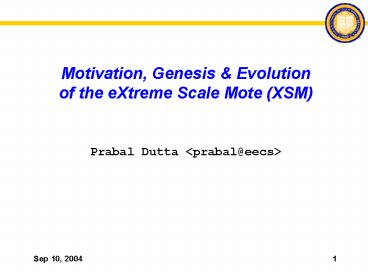Detection, Classification and Tracking of Targets in Distributed Sensor Networks
1 / 16
Title:
Detection, Classification and Tracking of Targets in Distributed Sensor Networks
Description:
... Data Collection vs. Event Detection. Data Collection. Signal ... Reduce sensing power (op amp FET ASIC) Decrease signal processing power consumption ... –
Number of Views:83
Avg rating:3.0/5.0
Title: Detection, Classification and Tracking of Targets in Distributed Sensor Networks
1
Motivation, Genesis Evolution of the eXtreme
Scale Mote (XSM)
Prabal Dutta ltprabal_at_eecsgt
2
Acknowledgements
- Crossbow Technology
- Mike Grimmer
- Ohio State
- Emre Ertin
- Hui Cao
- U.C. Berkeley
- Joe Polastre
- Cory Sharp
- Rob Szewczyk
- Virginia
- Lin Gu
- MITRE
- Ken Parker
- DARPA
3
Motivation Data Collection vs. Event Detection
- Data Collection
- Signal Reconstruction
- Reconstruction Fidelity
- Data-centric
- Data-driven Messaging
- Periodic Sampling
- High-latency Acceptable
- Periodic Traffic
- Store Forward Messaging
- Aggregation
- Phenomena Omnichronic
- Absolute Global Time
- Event Detection
- Signal Detection
- Detection and False Alarm Rates
- Meta-data Centric (e.g. statistics)
- Decision-driven Messaging
- Continuous Passive Vigilance
- Low-latency Required
- Bursty Traffic
- Real-time Messaging
- Fusion, Classification
- Rare, Random, Short-lived
- Relative Local Time
vs. ? ? ? ? ? ? ? ? ? ? ? ?
4
Differing Energy Usage Patterns
5
Extreme Scale Requirements
- Biggie-size A Line in the Sand (like PEG)
- ? Network Scale by 100x (10,000 nodes)
- ? Detection range by 6x (10m)
- ? Lifetime 8x (720hrs ? 1000hrs)
- Other areas also affected, but not covered
- Topology
- Classification
- Tracking
- Routing
- Time Synchronization
- Localization
- Application
- Visualization
6
LITeS Concept of Operations
7
Requirements (of the hardware platform)
- Functional
- Detection, Classification (and Tracking) of
- Civilians, Soldiers and Vehicles
- Reliability
- Recoverable Even from a Byzantine program image
- Performance
- Intrusion Rate 10 intrusions per day
- Lifetime 1000 hrs of continuous operation (gt 30
days) - Latency 10 30 seconds
- Coverage 10km2 (could not meet given
constraints) - Supportability
- Adaptive Dynamic reconfiguration of thresholds,
etc.
8
Genesis The Case for a New Platform
- Cost
- Eliminate expensive parts from BOM
- Eliminate unnecessary parts from BOM
- Optimize for large quantity manufacturing and use
- ? Network Scale by 100x (10,000 nodes)
- Reliability How to deal with 10K nodes with bad
image - ? Detection range by 6x (10m)
- New sensors to satisfy range/density/cost
tradeoff - ? Lifetime 8x (720hrs ? 1000hrs)
- Magnetometer Tstartup 40ms, Pss 18mW
- UWB Radar Tstartup 30s, Pss 45mW
- Optimistic lifetime 6000mWh / 63mW lt 100 hrs
- Must lower power
- Radio
- Fix anisotropic radiation and impedance mismatch
9
Hardware Evolution
Telos Low-power CPU 802.15.4 Radio Easy to
use Sleep-Wakeup-Active
MICAz MICA2 - CC1000 802.15.4
Radio Sleep-Wakeup-Active
XSM2 XSM Improvements Bug Fixes
XSM MICA2 Improved RF Low-power sensing
Recoverability Passive Vigilance-Wakeup-Active
10
The eXtreme Scale Mote
- Key Differences between XSM and MICA2
- Low-power Sensors
- Grenade Timer
- Radio Performance
11
Sensor Suite
- Passive infrared
- Long range (15m)
- Low power (10s of micro Watts)
- Wide FOV (360 degrees with 4 sensors)
- Gain 80dB
- Wakeup
- Microphone
- LPF fc 100Hz 10kHz
- HPF fc 20Hz 4.7kHz
- Gain 40dB 80dB (100-8300)
- Wakeup
- Magnetometer
- High power, long startup latency
- Gain 86dB (20,000)
12
Low-power Sensing through Duty-cycled Operation
- Motivation
- Low-latency, high-power sensors
- High-latency, low-power signal conditioning
- Components
- Unbalanced clock
- Tsetup phase
- Tsampe phase
- Thold phase
- S/H switch
- S/H capacitor
- S/H unity-gain buffer
13
Reliability through the Grenade Timer
- Motivation
- Basic idea presented by Stajano and Anderson
- Once started
- You cant turn it off
- You can only speed it up
- Our implementation
14
XSM RF Performance
15
Conclusions and Future Work
- Improve (or obviate) sensor wakeup circuits
- Lower false-alarm rate
- Low-power (zero-power?) wakeup
- Reduce sensing power (op amp ? FET ? ASIC)
- Decrease signal processing power consumption
- Consider space, time, message (and energy)
complexity
16
Discussion






























